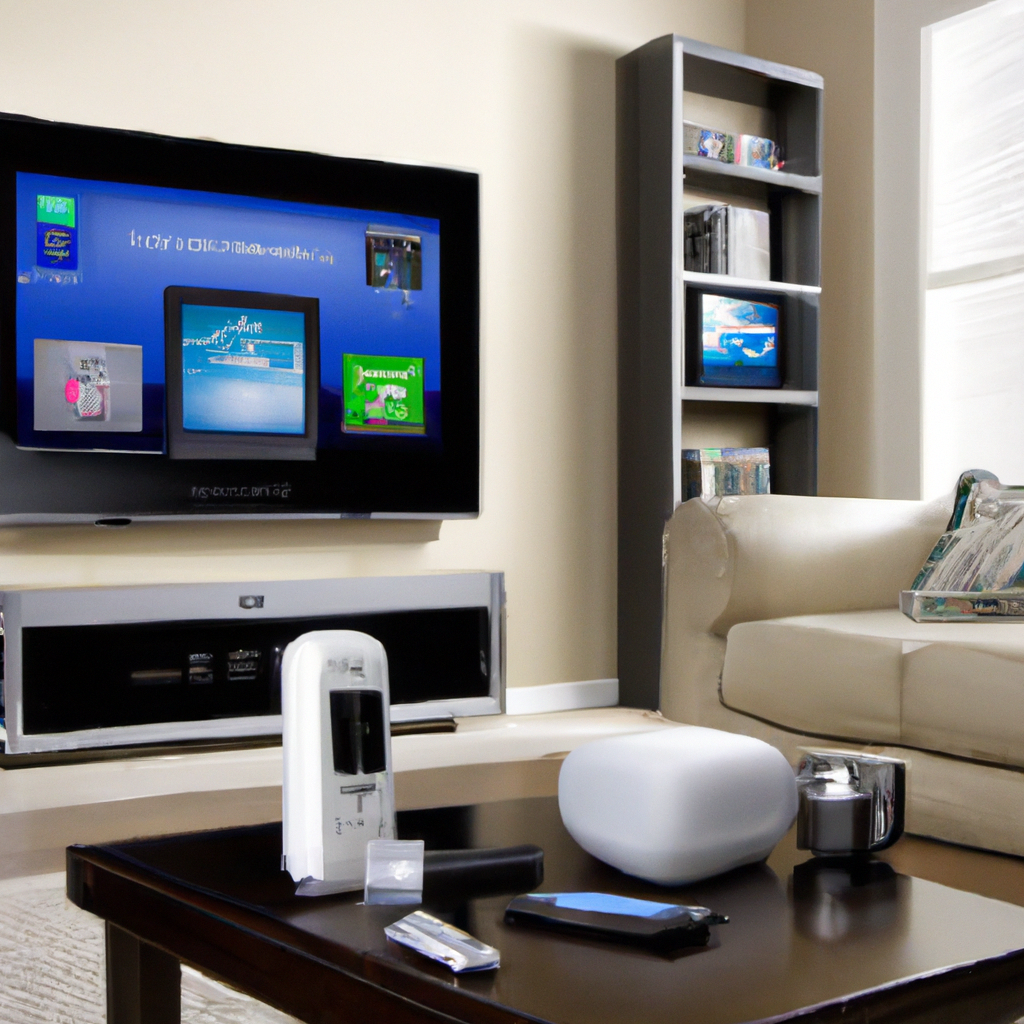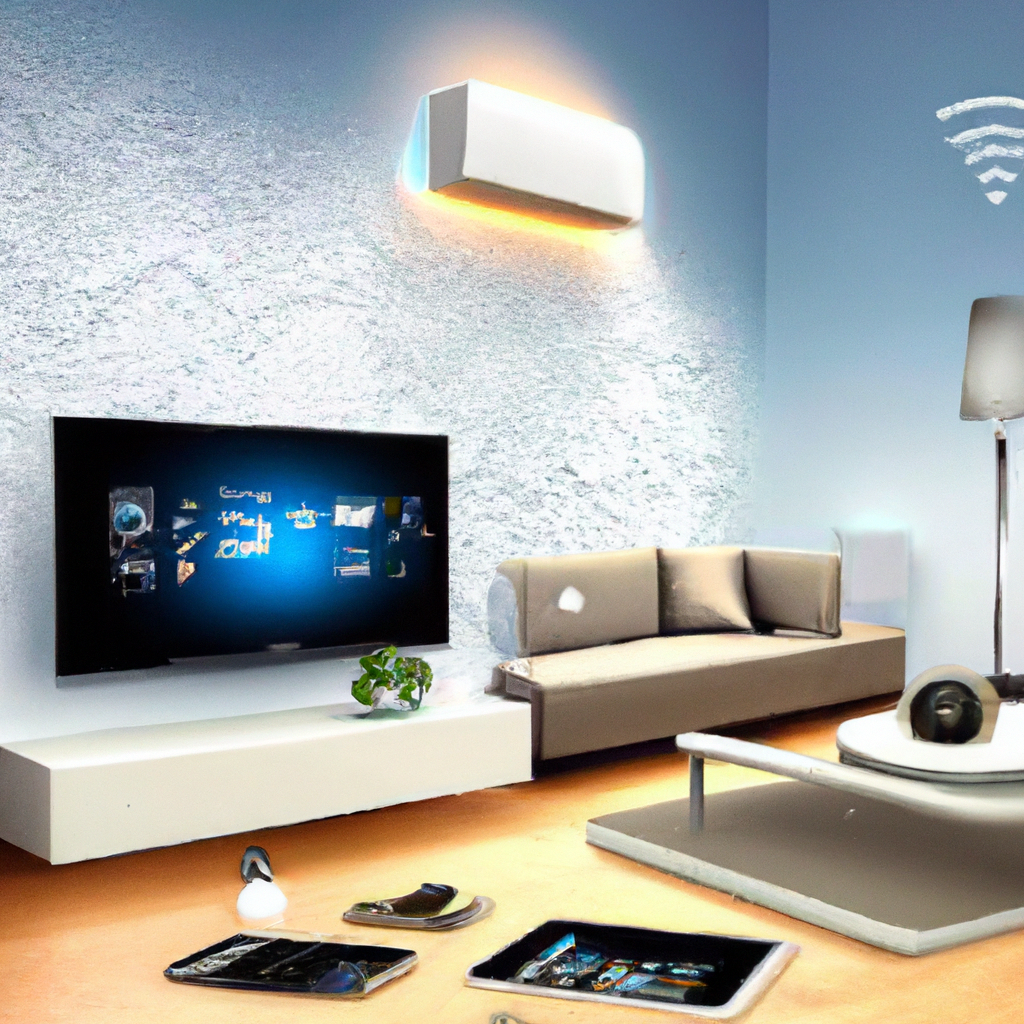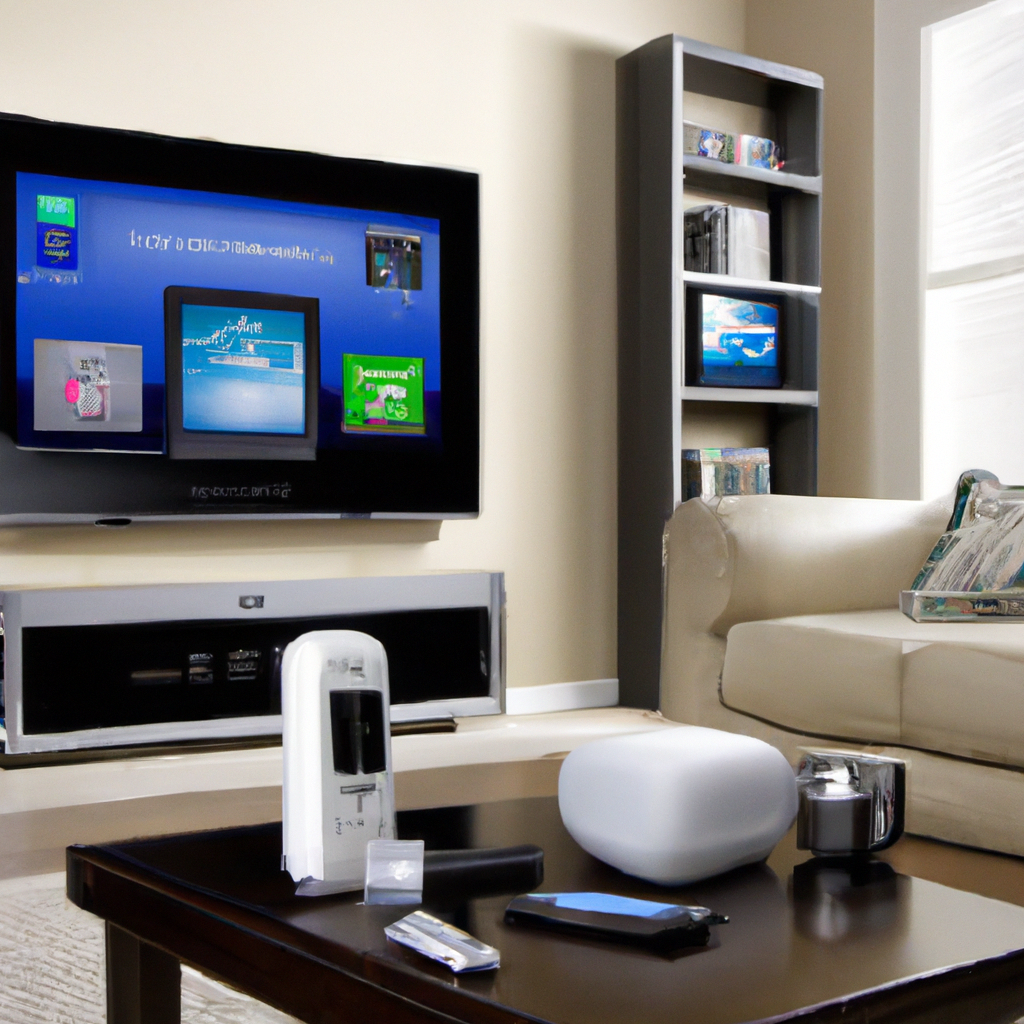Imagine a living room where all your smart devices seamlessly work together, creating an environment that caters to your every need. The convenience and efficiency of such a setup are undeniable, but making it a reality can sometimes feel like a daunting task. From controlling your lights to managing your home security system, this article will provide you with practical tips and tricks on how to ensure compatibility between different smart devices in your living room. So, get ready to transform your space into a tech-savvy haven and say goodbye to device compatibility woes.

1. Choose a Common Communication Protocol
When setting up a smart home, it is crucial to choose a common communication protocol for your devices. This ensures that they can seamlessly connect and communicate with each other. There are several common communication protocols to consider, including Wi-Fi, Bluetooth, Zigbee, Z-Wave, and Thread. Each protocol has its own advantages and disadvantages, so it’s important to research and choose the one that best suits your needs.
1.1 Wi-Fi
Wi-Fi is one of the most popular communication protocols for smart home devices. It offers a wide range and high data transfer rates, making it suitable for devices that require a stable and fast connection. However, Wi-Fi can be susceptible to interference from other devices and can consume a significant amount of power.
1.2 Bluetooth
Bluetooth is another commonly used communication protocol for smart home devices. It has a shorter range compared to Wi-Fi but consumes less power. Bluetooth is ideal for devices that are in close proximity to each other, such as speakers or headphones. However, it may not be suitable for devices that require a long-range connection.
1.3 Zigbee
Zigbee is a low-power wireless communication protocol that is commonly used for smart home devices. It operates on a mesh network, allowing devices to communicate with each other and extend the range of the network. Zigbee offers low latency and high reliability, making it suitable for applications where responsiveness and stability are important.
1.4 Z-Wave
Z-Wave is another popular protocol for smart home devices. It operates on a mesh network similar to Zigbee and offers a long-range, low-power communication solution. Z-Wave devices are known for their interoperability and are often compatible with other Z-Wave devices, regardless of the manufacturer.
1.5 Thread
Thread is a relatively new communication protocol that is gaining popularity in the smart home industry. It is designed to provide a reliable and secure connection for smart home devices. Thread operates on a low-power mesh network and offers seamless integration with other IP-based protocols, such as Wi-Fi. This protocol is ideal for devices that require long battery life and low latency.
Choosing the right communication protocol for your smart home devices is crucial to ensure compatibility and optimal performance. Consider factors such as range, power consumption, interoperability, and security when making your decision.
2. Research and Consider Device Compatibility
Once you have chosen a communication protocol, it is important to research and consider the compatibility of the devices you plan to incorporate into your smart home system. Ensuring device compatibility will save you from potential frustrations and complications down the line. Here are some steps to follow when researching and considering device compatibility:
2.1 Check manufacturer’s compatibility list
Most smart home device manufacturers provide a compatibility list on their websites. These lists outline the devices that are compatible with their products. Before purchasing any smart device, check the manufacturer’s compatibility list to ensure that it will work seamlessly with your existing or planned devices. This will help you avoid any compatibility issues that could hinder the functionality of your smart home system.
2.2 Read customer reviews
Customer reviews can be a valuable resource when researching device compatibility. Reading reviews from other users who have already set up similar smart home systems can provide insights into any compatibility issues they may have encountered. Look for reviews that specifically mention compatibility with other devices or systems to get a better understanding of how well the devices you are interested in will work together.
2.3 Consider device ecosystems
Some manufacturers offer their own ecosystems of devices that are designed to work together seamlessly. These ecosystems often ensure better compatibility between devices from the same brand, as they are specifically designed to integrate with each other. Consider whether you want to stick with devices from a single ecosystem or if you prefer the flexibility of mixing and matching devices from different manufacturers. Keep in mind that compatibility may vary when using devices from different ecosystems.
By thoroughly researching and considering device compatibility, you can ensure that your smart devices will work together harmoniously, minimizing any potential issues or frustrations.

3. Utilize a Smart Home Hub or Controller
To streamline and centralize the management of your smart home devices, utilizing a smart home hub or controller is highly recommended. A smart home hub serves as the central control point for all your connected devices, allowing you to manage and automate them from a single interface. Here are some key points to consider when choosing and utilizing a smart home hub or controller:
3.1 Function of a smart home hub
A smart home hub acts as a bridge between your devices and the control interface, whether it be a smartphone app or voice assistant. It enables communication between devices that operate on different protocols and provides a single point of control. With a smart home hub, you can create personalized automation routines, control devices remotely, and monitor the status of your smart home system.
3.2 Compatibility with different devices
When choosing a smart home hub, ensure that it is compatible with the communication protocols used by your smart devices. Some hubs support multiple protocols, while others are specific to a particular protocol. Make sure to check the compatibility specifications of the hub to ensure that it can effectively communicate and control all the devices in your smart home system.
3.3 Choosing the right smart home hub
With a wide range of smart home hubs available in the market, choosing the right one can be overwhelming. Consider factors such as compatibility, ease of use, available features, and scalability. You may also want to look for hubs that support popular voice assistant platforms, such as Amazon Alexa or Google Assistant, if you plan on controlling your smart home devices using voice commands.
It is important to note that not all smart home devices require a hub, especially if they connect directly to your Wi-Fi network. However, a smart home hub can greatly enhance your overall smart home experience by providing centralized control and automation capabilities.
4. Update Firmware and Software
Regularly updating the firmware and software of your smart home devices is essential to ensure optimal performance, security, and compatibility. Manufacturers often release updates to address bugs, add new features, and improve device compatibility. Here’s what you need to do to keep your devices up to date:
4.1 Check for updates regularly
Stay proactive by regularly checking for updates for your smart home devices. Most devices will have a settings or firmware update section in their respective smartphone apps or web interfaces. Make it a habit to check for updates at least once a month to ensure that you have the latest firmware and software versions.
4.2 Follow manufacturer’s instructions
When updating your smart home devices, always follow the manufacturer’s instructions. Some devices may require specific steps to initiate the update process, such as connecting the device to a computer or following a specific sequence of actions. Following the manufacturer’s instructions ensures that the update is applied correctly and reduces the risk of any issues during the update process.
4.3 Ensure all devices are updated
To maintain compatibility and optimal performance, it’s important to update all of your smart home devices regularly. This includes not only the hub or controller but also individual devices such as smart bulbs, thermostats, and security cameras. Neglecting to update a single device may result in compatibility issues or security vulnerabilities that could compromise your smart home system.
By regularly updating the firmware and software of your smart home devices, you can ensure that they continue to function properly and remain compatible with other devices and systems in your smart home setup.

5. Ensure Proper Power Management
Power management is a crucial aspect of maintaining a reliable and compatible smart home system. Insufficient power or improper handling of power can lead to device malfunctions, decreased performance, and even safety hazards. Consider the following tips to ensure proper power management in your smart home:
5.1 Check power requirements of devices
Before installing or using any smart home device, check the power requirements specified by the manufacturer. Ensure that your electrical system can provide the necessary power for all your devices. Overloading circuits or using incompatible power sources can cause devices to malfunction or fail to operate as intended.
5.2 Avoid overloading circuits
When setting up your smart home system, distribute your devices across multiple circuits to avoid overloading any single circuit. Overloading circuits can lead to tripped breakers or blown fuses, causing interruptions to your smart home system. If you are unsure about the electrical capacity of your home, consult an electrician to make sure your electrical system can handle the power requirements of your smart devices.
5.3 Use surge protectors
To protect your smart devices from power surges and voltage spikes, use surge protectors. Power surges can cause irreversible damage to your devices and render them incompatible or non-functional. Install surge protectors on outlets that power your smart home devices to minimize the risk of damage caused by electrical fluctuations.
By ensuring proper power management, you can prevent compatibility issues and ensure the smooth operation of your smart home devices.
6. Consider Interoperable Devices
Interoperability is an important factor to consider when selecting smart home devices. Interoperable devices can seamlessly communicate and integrate with each other, allowing for smoother operation and more extensive automation capabilities. Here are some tips for incorporating interoperable devices into your smart home:
6.1 Look for devices with compatibility certifications
When choosing smart home devices, look for devices that have compatibility certifications such as “Works with Alexa,” “Apple HomeKit compatible,” or “Google Assistant integration.” These certifications indicate that the devices have been tested and proven to work with popular smart home platforms, ensuring a higher level of interoperability.
6.2 Choose devices from the same brand or ecosystem
Opting for devices from the same brand or ecosystem can simplify the interoperability process. Many manufacturers design their devices to work seamlessly with each other, allowing for easier integration and control. By choosing devices from the same brand or ecosystem, you can minimize compatibility issues and achieve a more integrated smart home experience.
6.3 Seek out universal control options
Consider investing in a universal remote or control system that can manage multiple devices from different manufacturers. These control options act as a bridge between devices with different protocols, enabling you to control them using a single interface. Universal control options like Logitech Harmony or Control4 can enhance the interoperability of your smart home system.
By incorporating interoperable devices into your smart home, you can create a more cohesive and efficient system that maximizes automation capabilities and streamlines control.

7. Understand Device Limitations
Every smart home device has its own specific limitations that you should be aware of when setting up your smart home system. Understanding these limitations can help you make informed decisions and avoid compatibility issues. Consider the following points when assessing device limitations:
7.1 Recognize device-specific limitations
Each smart home device may have specific limitations that can impact its compatibility with other devices or systems. These limitations can include range limitations, compatibility with certain protocols, or the need for specific hardware or software requirements. Make sure to thoroughly research and understand the limitations of the devices you are considering to ensure compatibility and prevent any surprises.
7.2 Be aware of software and hardware constraints
Smart home devices rely on both software and hardware components to function properly. Software constraints may include limited integration options, restrictions on automation capabilities, or incompatible firmware versions. Hardware constraints can include limited processing power, memory, or outdated hardware that may hinder compatibility with newer devices. Understanding these constraints will help you make informed decisions when selecting and integrating devices into your smart home system.
7.3 Consider the age and generation of devices
As technology evolves, newer generations of smart home devices are released with enhanced features, improved compatibility, and optimized performance. When selecting devices for your smart home, consider the age and generation of the devices. Using outdated devices may result in compatibility issues and lack of support for newer protocols or features. However, upgrading all devices to the latest generation may not always be necessary or feasible, so strike a balance between compatibility and cost-effectiveness.
By understanding the limitations of smart home devices, you can make informed decisions when selecting and integrating devices into your smart home system, ensuring compatibility and optimal performance.
8. Read and Follow Setup Instructions
Properly setting up your smart home devices is crucial for ensuring compatibility and optimal performance. Each device comes with its own setup instructions that should be followed carefully. Here are some tips to help you get your devices up and running:
8.1 Read the device manuals
Before setting up any smart home device, take the time to read the device manual thoroughly. The manual provides essential information on setting up the device, connecting it to your network, and troubleshooting common issues. Familiarize yourself with the instructions to ensure a successful and compatible setup.
8.2 Follow the step-by-step setup instructions
Most smart home devices come with step-by-step setup instructions that guide you through the installation and configuration process. Follow these instructions carefully to ensure that the device is set up correctly and compatible with your existing system. Skipping or misunderstanding any steps can lead to compatibility issues or reduced functionality.
8.3 Troubleshoot issues during the setup process
If you encounter any issues during the setup process, consult the troubleshooting section of the device manual or visit the manufacturer’s support website. Troubleshooting common setup issues can help you identify and resolve any compatibility issues early on, ensuring a smooth setup process.
By reading and following the setup instructions provided by the device manufacturers, you can ensure a successful and compatible setup, minimizing any potential issues or complications.

9. Seek Professional Assistance if Needed
Setting up a smart home system can be complex, especially if you have limited knowledge or experience in home automation. In such cases, seeking professional assistance can ensure that your smart devices are installed and configured correctly. Consider the following options for professional assistance:
9.1 Consult smart home professionals
Smart home professionals and consultants specialize in designing and installing smart home systems. They can assess your needs, recommend compatible devices, and ensure seamless integration. Consulting with a smart home professional can save you time, frustration, and potential compatibility issues by relying on their expertise.
9.2 Hire an electrician for wiring and power needs
If your smart home setup requires additional wiring or electrical work, hiring a licensed electrician is recommended. An electrician can ensure that the necessary wiring is installed safely and according to electrical standards. They can also help assess your electrical system’s capacity to handle the power requirements of your smart devices, minimizing the risk of compatibility issues or electrical hazards.
9.3 Consider professional setup and configuration
Some smart home device manufacturers offer professional installation and configuration services. These services often include setup, integration, and optimization of your devices, ensuring compatibility and optimal performance. Although this option may involve an additional cost, it can provide peace of mind and save you time and effort.
Seeking professional assistance can help ensure that your smart home devices are installed, configured, and integrated correctly, guaranteeing compatibility and optimal performance.
10. Test and Experiment with Device Combinations
After setting up your smart home system, it’s important to test and experiment with different device combinations to ensure compatibility and identify any potential issues. Here are some ways to test and experiment with your smart home devices:
10.1 Experiment with different device combinations
Try combining different devices within your smart home system to see how they interact and work together. Test different scenarios and use cases to ensure that the devices are compatible and perform as expected. Experimenting with different device combinations allows you to discover any limitations or compatibility issues early on.
10.2 Test compatibility before making permanent setups
Before permanently installing or mounting devices, test their compatibility and functionality in different locations or setups. This is especially important for devices that rely on wireless communication, such as smart speakers or sensors. Testing compatibility beforehand allows you to make adjustments and find the optimal setup for your devices.
10.3 Adjust and fine-tune settings for optimal performance
Once you have tested different device combinations, adjust and fine-tune the settings of your devices to achieve optimal performance. Explore the settings and configuration options provided by each device to customize and optimize their functionality. Fine-tuning settings ensures that your devices are fully compatible and performing at their best.
By testing and experimenting with different device combinations, you can ensure compatibility and identify any issues or limitations. Adjusting settings and fine-tuning your devices will optimize their performance and enhance your overall smart home experience.
In conclusion, ensuring compatibility between different smart home devices in your living room involves careful consideration of communication protocols, device compatibility, proper power management, and understanding device limitations. By following these tips and guidelines, you can create a harmonious and compatible smart home system that brings convenience, efficiency, and enjoyment to your living room.
